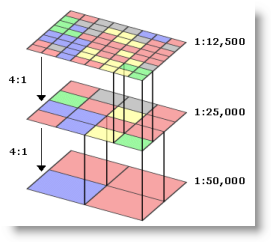Your raster data source does not contain a raster pyramid. This is one of a number of ways to improve performance for raster data display.
Solutions
- Calculate raster pyramids for your raster dataset.
- Alternatively, you can specify scale-dependent drawing for your raster dataset, especially if it is not possible to generate a raster pyramid for your data. You can design your layer so that it turns on at appropriate visibility scales and will not draw at other scales. For example, a detailed ortho image that has a 1-foot resolution should only be displayed as users zoom in on areas at larger scales. You can support this by using scale-dependent drawing. Your raster layer would be turned on in the display at an appropriate range of visibility scales, and its display would turn off outside the scale range.
Learn more about drawing layers at specific map scales
A helpful approach is to work with your map by navigating—zooming in and out—until you find appropriate map scales for turning on the raster display. See Setting a visible scale based on the current scale to help you set the proper map scales for scale-dependent rendering.
More information
Pyramids are reduced-resolution representations of your dataset used to improve performance. Pyramids can speed up the display of raster data by retrieving only the data at a specified resolution that is required for the display. With pyramids, a lower-resolution copy of the data displays quickly when drawing the entire dataset. As you zoom in, levels with finer resolutions are drawn; performance is maintained because you're drawing successively smaller areas.
ArcGIS automatically chooses the most appropriate pyramid level based on the map display scale.
